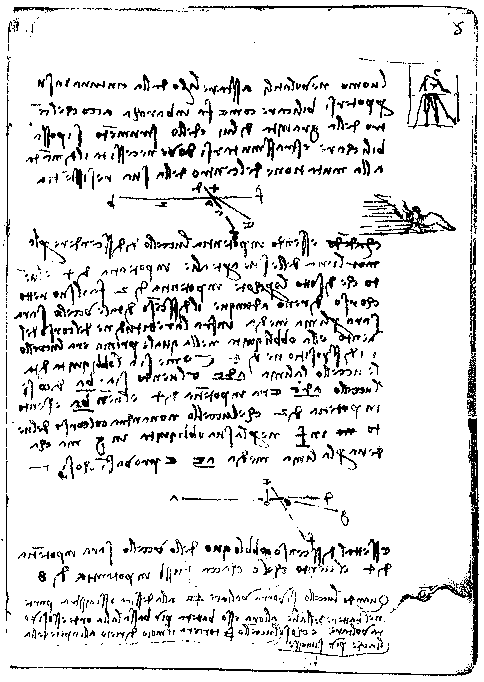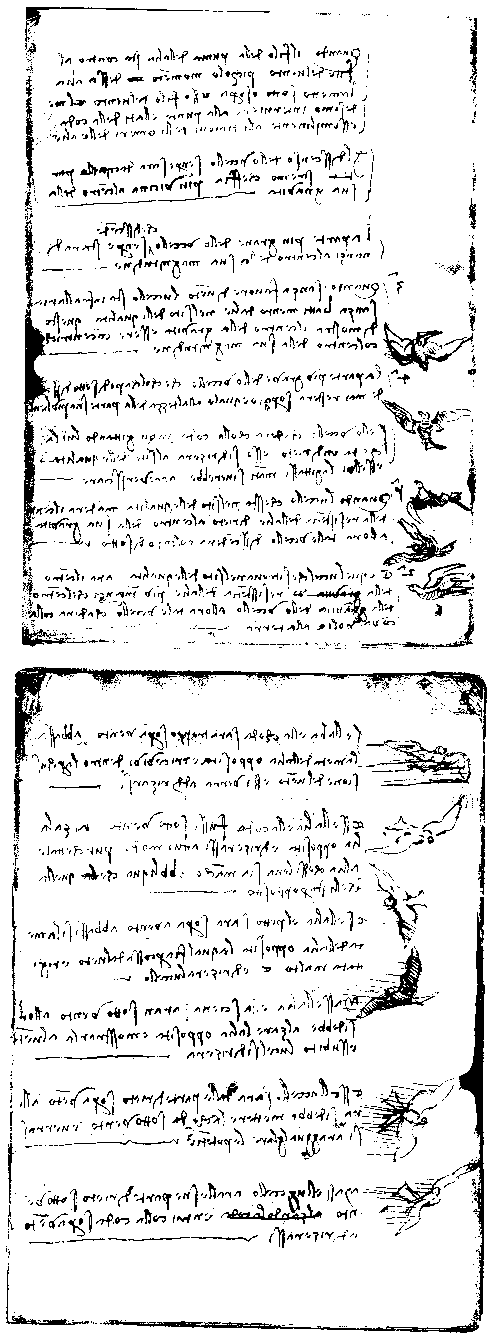
FROM LEONARDO'S TREATISE ON THE FLIGHT OF BIRDS.
Paris, 1893.

FROM LEONARDO'S TREATISE ON THE FLIGHT OF BIRDS.
Paris, 1893.
Those feathers which are farthest from their fastening will be the most flexible; then the tops of the feathers of the wings will be always higher than their origins, so that we may with reason say, that the bones of the wings will be lower in the lowering of the wings than any other part of the wings, and in the raising these bones of the wing will always be higher than any other part of such a wing. Because the heaviest part always makes itself the guide of the movement.
The kite and other birds which beat their wings little, go seeking the course of the wind, and when the wind prevails on high then they will be seen at a great height, and if it prevails low they will hold themselves low.
When the wind does not prevail in the air, then the kite beats its wings several times in its flight in such a way that it raises itself high and acquires a start, with which start, descending afterwards a little, it goes a long way without beating its wings, and when it is descended it does the same thing over again, and so it does successively, and this descent without flapping the wings serves it as a means of resting itself in the air after the aforesaid beating of the wings.
When a bird which is in equilibrium throws the centre of resistance of the wings behind the centre of gravity, then such a bird will descend with its head down.
This bird which finds itself in equilibrium shall have the centre of resistance of the wings more forward than the bird's centre of gravity, then such a bird will fall with its tail turned to the earth.
When the bird is in the position and wishes to rise it will raise
its shoulders and the air will press between its sides and the
point of the wings so that it will be condensed and will give
the bird the movement toward the ascent and will produce a momentum
in the air, which momentum of the air will by its condensation
push the bird up.
Of four movements performed by birds reflected and incidental to different aspects of the wind.
The slanting descent of birds being made against the wind will be made under the wind, and its reflex movement will be made above the wind. But if such an incidental movement is made to the east, the wind blowing from the north, then the northern wing will remain under the wind; in the reflex movement will do the same, so that, at the end of this reflex the bird will find itself with its face to the north.
And if the bird descends to the south, the northern wind reigning, he will make such a descent above the wind and his reflex movement will be under the wind; but here comes in a long dispute which will be told in its place, because here it seems to happen that he cannot make the reflex movement.
When the bird makes his reflex movement above the wind then he will mount much more than belongs to his natural momentum, seeing that he adds to that the help of the wind which, entering under him, acts as a wedge. But when he has reached the end of the ascent he will have used up his momentum, and he will have remaining only the help of the wind, which would overturn him because he strikes it with his breast, were it not that he lowers the right or left wing, which makes him turn to the right or to the left descending in a semi-circle.
The descent of the bird will always be by that extremity which shall be the nearest to its centre of gravity. The heaviest part of the bird which descends will remain always in front of the centre of its mass.

FROM LEONARDO'S TREATISE ON THE FLIGHT OF BIRDS.
Paris, 1893.

FROM LEONARDO'S TREATISE ON THE FLIGHT OF BIRDS.
Paris, 1893.
When without help of the wind the bird remains in the air without
flapping its wings, this shows that the centre of its gravity
is concentric with the centre of its mass.
The man in the flying-machine to be free from the waist up that
he may be able to keep himself in equilibrium as he does in a
boat, so that the centre of his gravity and that of the instrument
may set itself in equilibrium and change when necessity requires
it to the changing of the centre of its resistance.
NOTE.This paragraph refers to the figure of the man seen in Plate VIII. Of course a supporting surface above the man is presupposed. The interval between Leonardo's writing and Lilienthal's practical work is nearly four hundred years. The former has clearly shown that he understood the supporting power of aerocurves, and in this last paragraph he indicates a knowledge of the fact that the chief difficulty which a soaring man encounters is that of keeping his centre of gravity at all times in the right place. To appreciate Leonardo one must understand Lilienthal. See Mr. Chanute's "Progress in Flying-Machines," p. 285, line 30; and p. 286, line 1.Ed.
cbbg